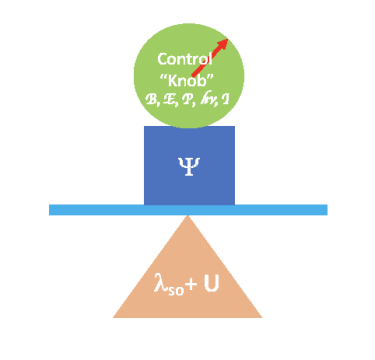Research
Discovery and Study of Novel Quantum Materials
Our research program encompasses a methodical search for new materials in single-crystal form, and a systematic effort to elucidate the underlying physics of these materials (e.g. Physics of Spin-orbit-coupled Oxides).
This research program has been supported by both NSF and DOE.
Materials Discovery and Synthesis: We search for new, interesting quantum materials and sythesize them in single-crystal form using flux, floating-zone, electrochemical deposition and the newly developed magneto-synthesis techniques (see Section Facilities).
We are particularly interested in high-Z (Z being atomic number) materials with comparable Coulomb and spin-orbit interactions (see Section Quantum Materials).
Field-Tailoring Technology or Magneto-Synthesis: The discovery of novel quantum materials requires innovative synthesis approaches. We have been developing a new Field-Tailoring Technology (FTT) that utilizes a laser molten/floating zone furnace coupled with a superconducting magnet to synthesize highly ordered materials that are inaccessible via existing techniques (see proof-of-concept results in npj Quantum Mater. 5, 83 (2020) and more recent work).
Materials Characterization: We utilize a wide suite of tools for experimental studies of structural, transport, magnetic, thermal and dielectric properties as functions of chemical composition, temperature, magnetic field, pressure and electrical current. Measurements are often carried out at extreme conditions, i.e., ultralow temperatures, high magnetic fields and high pressures (see Section Facilities)
A Common Feature Shared by All Materials We Are Interested: Quantum states of these materials are primarily dictated by a combined effect of both spin-orbit and Coulomb interactions and feature a high susceptibility to external stimuli, such as magnetic field B, electrical field E, pressure P, light hv or electrical current I. These external stimuli readily couple to the lattice and are control "knobs" we utilize to discover and study exotic states, as schematically shown below.

Highlights of Recent Work
I. Chiral orbital currents
- Emergent inductance of chiral orbital currents in a bulk ferrimagnet, Gang Cao, Hengdi Zhao, Yu Zhang, Alex Fix, Tristan R. Cao, Dhruva Ananth, Yifei Ni, Gabriel Schebel, Rahul Nandkishore, Itamar Kimchi, Hua Chen, Feng Ye and Lance E. DeLong; Physical Review Letters 135, 146504 (2025)
- Control of chiral orbital currents in a colossal magnetoresistance material, Yu Zhang, Yifei Ni, Hengdi Zhao, Sami Hakani, Feng Ye, Lance DeLong, Itamar Kimchi and Gang Cao, Nature 611, 467–472 (2022)
- Current-sensitive Hall effect in a chiral-orbital-current state, Yu Zhang, Yifei Ni, Pedro Schlottmann, Rahul Nandkishore, Lance E. DeLong, and Gang Cao, Nature Communications 15, 3579 (2024)
- Colossal magnetoresistance via avoiding fully polarized magnetization in the ferrimagnetic insulator Mn3Si2Te6, Yifei Ni, Hengdi Zhao, Yu Zhang, Bing Hu, Itamar Kimchi and Gang Cao, Physical Review B 103, L161105 (2021)
II. Quantum spin liquids in trimer lattices
- Interaction of magnetic fields with spinons in a fractionalized state, Yu Zhang, Hengdi Zhao, Tristan R. Cao, Rahul Nandkishore, Pedro Schlottmann, Lance E. DeLong and Gang Cao, npj Quantum Materials 10, 86 (2025); https://doi.org/10.1038/s41535-025-00809-9
- Transition between heavy-fermion strange metal and quantum spin liquid in a 4d-electron trimer lattice, Hengdi Zhao, Yu Zhang, Pedro Schlottmann, Rahul Nandkishore Lance E. DeLong, and Gang Cao, Physical Review Letters 132, 226503 (2024)
- Interaction of magnetic fields with spinons in a fractionalized state, Yu Zhang, Hengdi Zhao, Tristan R. Cao, Rahul Nandkishore, Pedro Schlottmann, Lance De Long, and Gang Cao, arXiv:2408.13665v2. To appear in npj Quantum Materials (2025)
- Quantum liquid from strange frustration in the trimer magnet Ba4Ir3O10, G. Cao, H. D. Zhao, H. Zheng, Y. F. Ni, Christopher. A. Pocs, Y. Zhang, Feng, Ye, Christina Hoffmann, Xiaoping Wang, Minhyea Lee, Michael Hermele and Itamar Kimchi, npjQuantum Materials. 5, 26 (2020)
- Emergence of spinons in layered trimer iridate Ba4Ir3O10,Y. Shen, J. Sears, G. Fabbris, A. Weichselbaum, W. Yin, H. Zhao, D. G. Mazzone, H. Miao, M. H. Upton, D. Casa, R. S. Acevedo-Esteves, C. Nelson, A. M. Barbour, C. Mazzoli, G. Cao, and M. P. M. Dean, Physical Review Letter 129, 207201 (2022)
III. Electrical control of quantum states
- Electrical Control of Structural and Physical Properties via Spin-Orbit Interactions in Sr2IrO4, G. Cao, J. Terzic, H. D. Zhao, H. Zheng, Peter Riseborough, L. E. DeLong, Physical Review Letter 120, 017201 (2018)
- Nonequilibrium orbital transitions via applied electrical current in calcium ruthenate, Hengdi Zhao, Bing Hu, Feng Ye, Christina Hoffmann, Itamar Kimchi and Gang Cao; Physical Review B 100, 241104(R) (2019)
- Topical Review: Towards Electrical-Current Control of Quantum States in Spin-Orbit-Coupled Matter, Gang Cao, Journal of Physics: Condensed Matter 32, 423001 (2020)
IV. Magneto-synthesis
- Quest for quantum states via field-altering technology, Gang Cao, Hengdi Zhao, Bing Hu, Nicholas Pellatz, Dmitry Reznik, Pedro Schlottmann and Itamar Kimchi, npj Quantum Materials5, 83 (2020)
- Field-Tailoring Quantum Materials: Magneto-Synthesis of Metastable Metallic States in a Spin-Orbit-Coupled Trimer Iridate, Tristan R. Cao, Hengdi Zhao, Xudong Huai, Arabella Quane, Varun Narayanan, Thao T. Tran, Feng Ye and Gang Cao, npj Quantum Materials (2026), in press
V. High pressure and magnetostriction studies
- Observation of a pressure-induced transition from interlayer ferromagnetism to intralayer antiferromagnetism in Sr4Ru3O10, H. Zheng, W.H. Song, J. Terzic, H. D. Zhao, Y. Zhang, Y. F. Ni, L. E. DeLong, P. Schlottmann and G. Cao, Physical Review B 98, 064418 (2018)
- Persistent Insulating State at Megabar Pressures in Strongly Spin-Orbit-Coupled Sr2IrO4, Chunhua Chen, Yonghui Zhou, Xuliang Chen, Tao Han, Chao An, Ying Zhou, Yifang Yuan, Bowen Zhang, Shuyang Wang, Ranran Zhang, Lili Zhang, Changjing Zhang, Zhaorong Yang, Lance E. DeLong and Gang Cao, Physical Review B 101, 144102 (2020)
- Lattice flexibility in Ca3Ru2O7: Control of electrical transport via anisotropic magnetostriction, Hengdi Zhao, Hao Zheng, Jasminka Terzic, Wenhai Song, Yifei Ni, Yu Zhang, Pedro Schlottmann, and Gang Cao, Physical Review B 104, L121119 (2021)
VI. Key Issue Review and book on Iridates and ruthenates
- The Challenge of Spin-Orbit-Tuned Ground States in Iridates: A Key Issues Review, Gang Cao and Pedro Schlottmann, Reports on Progress in Physics 81 042502 (2018)
- Physics of Spin-Orbit-Coupled Oxides, Gang Cao and Lance E. De Long, Oxford University Press; Oxford, 2021

